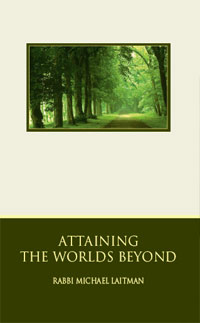To Perceive or Not to Perceive the Creator
Much paper has been wasted by philosophers discussing the impossibility of comprehending the Creator. Judaism, as a doctrine founded on the personal experimentation of the Kabbalists, answers the question: How can we discourse on the possibility or impossibility of perceiving the Creator prior to perceiving Him?
Any definite statement implies a certain measure of perception. Therefore, it is first necessary to define what is meant by saying “it is impossible to perceive the Creator or infinity.” On what basis can we claim that we understand these notions?
It is clear that when we speak of comprehending the Creator, we imply that such comprehension would be made with our sensory organs and our intellect, just as is done when researching anything else in our world. Moreover, all concepts must be understandable to everyone in our world, just like any other concepts that are being researched. Thus, the ideas must embody something tangible and real, something that can be discerned by our sensory organs.
Perception of the Creator with Spiritual Organs
The closest boundary of perception is found in the organs of tactile sensation, when we come in direct contact with the object’s external boundary. As to using our sense of hearing, we are no longer in direct contact with the object itself, but instead come in contact with the intermediary that is transmitting the object (like air), which has had contact with the object’s external boundary, be it the vocal cords of a human being, or the oscillating surface that emits a sound wave. Similarly, we use our spiritual organs of perception to perceive the Creator.
A sensation of contact (much like a tactile sensation) with the external boundary of the created being is known as “prophetic vision.” On the other hand, a contact that has been infracted by a certain other medium that came into contact with the external boundary of the created being, (much like the sensation of hearing) is known as “prophetic hearing.”
Interpreting Visible and Audible Spiritual Phenomena
“Prophetic vision” is considered to be the most obvious disclosure (just as in our world, we desire to see an object and consider this to be the most complete perception of the object) because we come into direct contact with the Light emanating from the Creator Himself.
On the other hand, “prophetic hearing” (the voice of the Creator) is defined by the Kabbalists as incomprehensible, as opposed to prophetic vision. It is similar to our ability to hear sound waves, since what we are really sensing are the signals of the intermediary spiritual object that emanate from the contact of the intermediary object with the external boundary of the Creator. We interpret these waves, just as in the case of prophetic vision, as sound waves.
Kabbalists who have attained the prophetic understanding of the Creator first perceive Him through their spiritual counterparts of sight or hearing. Later, they interpret what they perceived. Notably, comprehending visible phenomena gives them complete cognition, whereas it is impossible to comprehend the nature of a purely auditory phenomenon.
But, just as in our world, even simple hearing is sufficient to grasp qualities of the object being studied (even a person blind from birth senses many qualities of those nearby), so spiritual cognition derived through hearing is also sufficient. This is due to the fact that with spiritual hearing, the information that reaches one, contains within it all the other concealed qualities.
Our Comprehension Is Limited by Our Senses
The commandment of comprehending the Creator in essence is reduced to the perception of Him by means of spiritual sight and hearing to such a degree that we are absolutely certain that we are conscious of a full visual and audible contact with the Creator, which is called “face to face.”
Creation, and the governing of those beings that have been created, occur through two opposing phenomena: the concealment of the omnipotence of the Creator, and the gradual Revelation of His Omnipotence, so that the creations can perceive Him through their corrected qualities.
For this reason, one of the names of the Creator in Hebrew is Maatzil, from the word tzel, “shadow;” there is another name as well: Boreh, derived from the words bo-re’eh, “come and see.”
Consequently, from these words were derived the names of the two worlds: Atzilut and Beria.
We are incapable of comprehending the true state of creation, but only that which our senses can perceive, whether material or spiritual.
The Paradox of Our Present Self-Centered Perception
Our consciousness divides everything that exists in the world into either an emptiness or sufficiency. This is so, even though “learned people” insist that there really is no such concept as complete emptiness or a vacuum.
This concept is beyond our comprehension, because we can only understand what is missing through our senses. But we are able to sense an absence or an emptiness if we compare the relation of that which exists in this world to our situation after our death .
However, even while living in this world, we feel as if everything outside our bodies is somehow absent and does not really exist at all. The truth is just the opposite: What exists outside of us is eternal and existing, while we ourselves are nothing and disappear into nothing.
These two concepts are absolutely inadequate because our sensations lead us to believe that everything that exists is connected to us and exists only within that framework; whereas everything outside of us does not carry any worth. But reason points to the opposite—that it is we who are insignificant, while everything outside us is eternal.
 “A Beginner’s Manual for Perceiving the Creator” is based on the book, Attaining the Worlds Beyond by Dr. Michael Laitman.
“A Beginner’s Manual for Perceiving the Creator” is based on the book, Attaining the Worlds Beyond by Dr. Michael Laitman.

